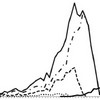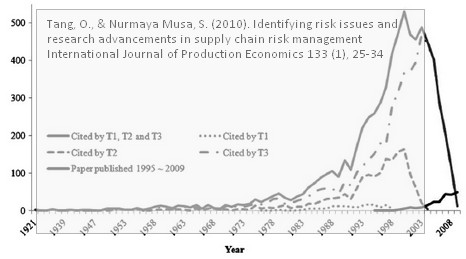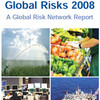 What are the current gaps that waiting to be closed in supply chain risk management research? Here is a paper that claims to have the answer: Identifying risk issues and research advancements in supply chain risk management, co-written by Ou Tang and S. Nurmaya Musa. Not only does this paper investigate the research development in supply chain risk management (SCRM),which has shown an increasing global attention in recent years, it also shows the incremental evolutions and advancements of SCRM discipline, and defines several sets or clusters of topics and how these have changed over the years.
What are the current gaps that waiting to be closed in supply chain risk management research? Here is a paper that claims to have the answer: Identifying risk issues and research advancements in supply chain risk management, co-written by Ou Tang and S. Nurmaya Musa. Not only does this paper investigate the research development in supply chain risk management (SCRM),which has shown an increasing global attention in recent years, it also shows the incremental evolutions and advancements of SCRM discipline, and defines several sets or clusters of topics and how these have changed over the years.
Material, financial and information flows
The article takes a familiar approach in classifying and categorizing different supply chain risks the literature they review, namely
- material flow risks
- financial flow risks, and
- information flow risks,
an approach many supply chain researchers will readily recognize, i.e. the “boxes, bucks and bytes” in Kleindorfer and Wassenhove’s Managing Risk in Global Supply Chains, strangely enough not mentioned in their collection of literature. On a side note, to complete the flows that make up supply chain management, Wassenhove added two more flows,
- people flows, and
- knowledge or skills flows
in his book on Humanitarian Logistics, flows that in my opinion are equally important in supply chain risk management, as people are often the weakest link in the supply chain, and people are the agents that more often than not perceive risks as different from what objective measures tell them to be.
Risk definiton
When looking at their list of 80 or so references I was surprised to not find many articles I would have considered important in looking back how the supply chain risk management literature has evolved. However, when looking at the definition of supply chain risk they employ, it became clear to me why they were so “selective”:
supply chain risk should refer to (i) events with small probability but may occur abruptly and (ii) these events bring substantial negative consequences to the system
While the authors may subscribe to a risk definition similar to that of Paul Kleindorfer, I beg to disagree here, as I believe that the focus on risk as something that is only very negative is not the right way to address the full spectrum of risk issues. Consequently, I think the authors have not fully captured the development of supply chain risk management research.
Literature review
First the authors describe how they found the articles they reviewed:
Based on the description of definitions in previous section, we use search keywords supply chain, supply chain risk or supply chain risk management together with risk or uncertainty. After obtaining these articles,we use the criteria ‘‘high impact and low probability risk’’ to filter the most relevant ones. Finally we have shortlisted and reviewed 138 articles between the years of 1995 and the first half of 2008.
This is a valid approach, but I would have liked to know more about the search keywords. Are those the keywords employed by the authors of the reviewed articles? If so they may not always fully describe the content the article, since the number of keywords allowed is often limited by the journal publisher, and some authors may deliberately chose to use certain keywords and to omit other keywords. Or did the authors (of this article) read and then decide what keywords that fit? Also a bit puzzling to me is that they say to have reviewed 138 articles, but only 80 or so made it into the references of the article, which in hindsight may account for the articles that I thought were missing from this review.
Solid work
Having said the above, I am still very much impressed with the work the authors have done. Using citation and co-citation analysis, they identify three separate time periods and topical clusters within those periods.
Main issues discussed during the year 1995 until 1999 include financial risk management and operations strategies such as adoption of lean concept and early supplier involvement .Between years 2000 and 2003, the number of articles in SCRM slowly increases. Main issues vary from operation plans to relationship of supply chain partners. In the same time period, we also note the emerging of studies on information technology and information flow. Meantime, we also note a rising discussion on globalization risk associating with political and cultural practices. A dramatic increase of publications starts in 2004, from which SCRM exhibits a steady rising of interest from academic researchers and practitioners. Challenges and opportunities of outsourcing to low cost countries are the favorite discussion topics. Others include supply chain partner relationship, supply chain environmental, economy and political issues and growth of information sharing and security. Several studies on financial risk are also noted.
Note the scale on the y-axis above. I must say that I find it hard to believe that while there haven’t been written that many articles on supply chain risk management, but obviously more than enough, they have actually been cited close to 500 times in 2003. Possible, yes, but the authors do not say where the citations have been taken from, so it is hard to judge credibility of the figure.

Nonetheless, the figure leaves no doubt that supply chain risk management has seen a dramatic increase in interest in the recent decade.
Research gaps
The authors identify a number of research gaps or possible new research strands for budding researchers:
Robust planning: exploring the uncertainty inherent in a supply chain, and developing optimization decisions which provide more predictable results.
Revenue management: using pricing policies to allocate and relocate capacity from disrupted to non-disrupted segments of the supply chain.
Agency theory: investigating understanding supply chain interdependencies in a systems perspective.
Option theory: integrating real options and financial options for improving strategic/tactical and operational decisions.
System dynamics: understanding and analyzing the inherent control policies in a supply chain, e.g. the bullwhip effect in supply chain disruption management.
Reverse logistics: using returned items as a backup or reserve inventory to improve supply chain reliability and to reduce tied-up capital
I find this a very interesting list, especially the last suggestion, which also adds in sustainability, perhaps the coming issue in future supply chain management, as reported by eft.com.
Critique
This is a well-researched article. It is perhaps not so well written or well-structured. By that I mean that it doesn’t flow so well when reading it, and it takes some time for the main points to sink in. Some figures are not self-explanatory and are also not described in enough detail in the text to fully understand what they convey. Overall however, the article brilliantly sums up the core topics of supply chain risk management of the past, the present, and where it may be headed to in the future.
Reference
Tang, O., & Nurmaya Musa, S. (2010). Identifying risk issues and research advancements in supply chain risk management International Journal of Production Economics 133 (1), 25-34 DOI: 10.1016/j.ijpe.2010.06.013
Author links
- researchgate.net: Qu Tang
- linkedin.com: S Nurmaya Musa
Related posts
- husdal.com: A literature review in supply chain risk management
- husdal.com: Risk and uncertainty in supply chains












